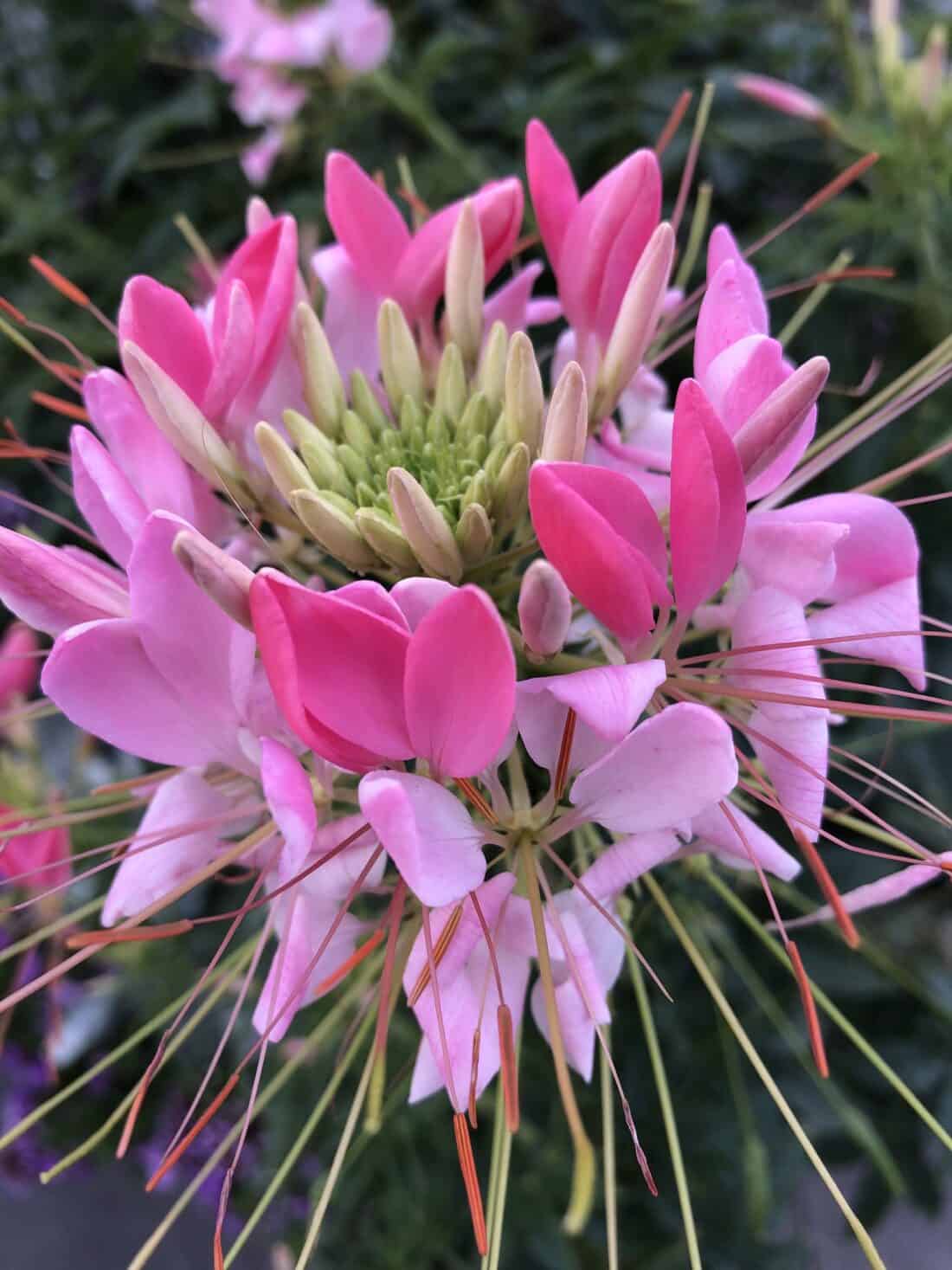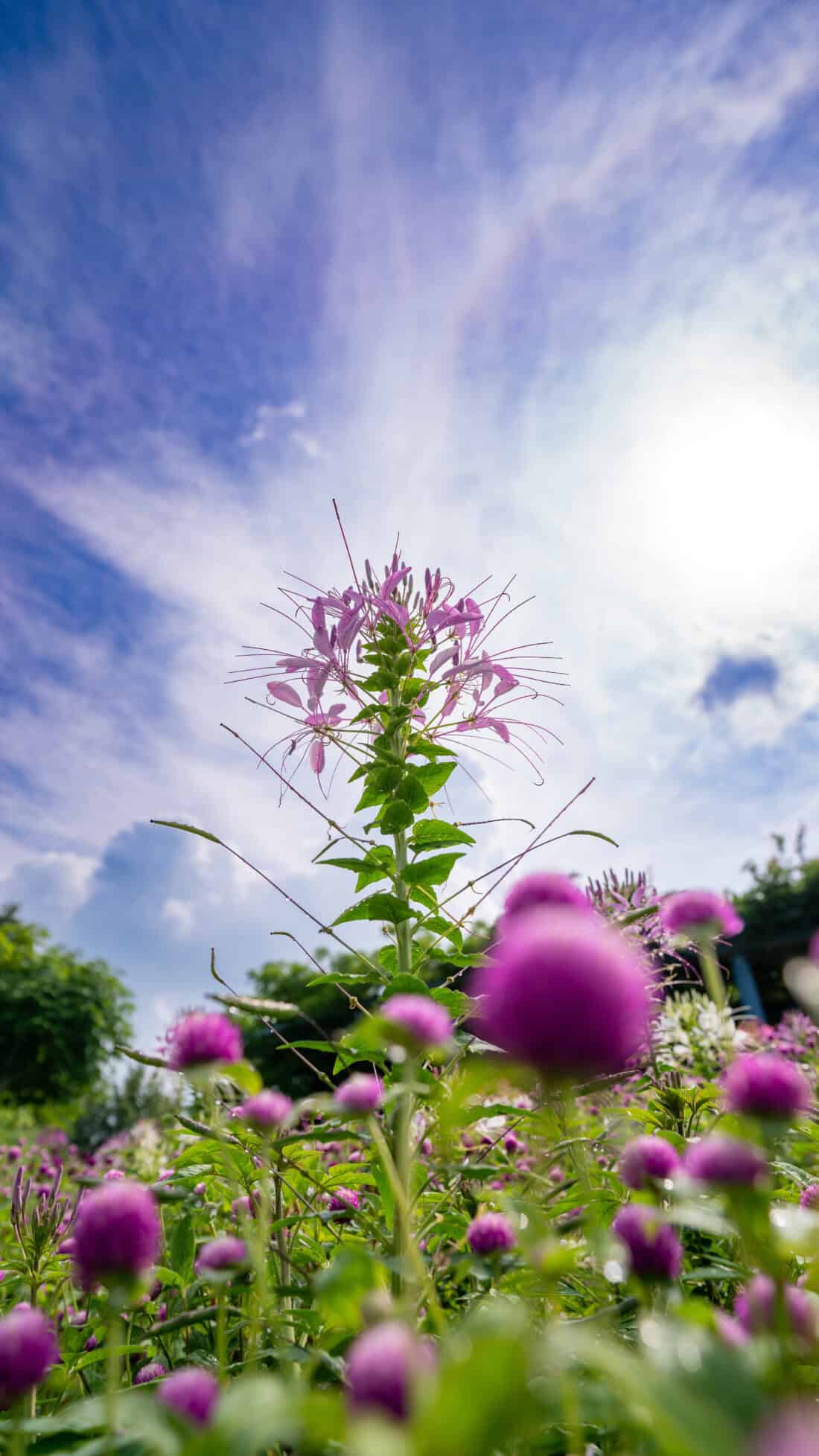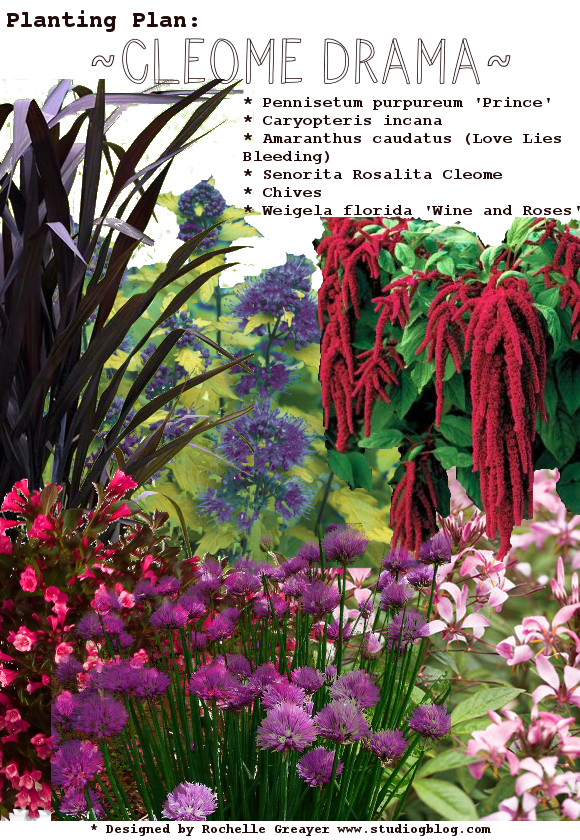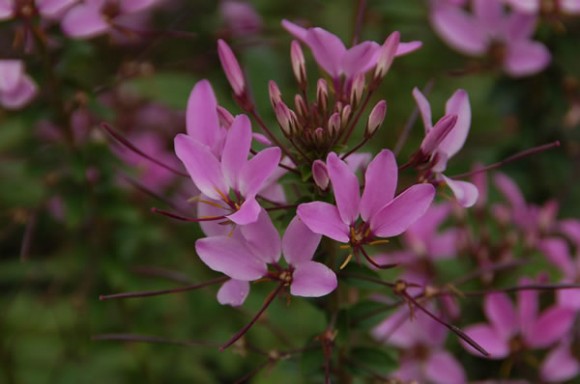I hate Cleome. My disdain stems from a bad experience back when I was a baby gardener. In my baby gardener days, I had a tiny plot in front of a duplex (so really, I just had the right-hand side of the garden).
I was eager to make my mark (my parents, of course, got to make all planting decisions in every garden I’d ever worked in or enjoyed up to that point). This was my very own first house with a small yard and I made all sorts of experimental mistakes. I built weirdly shaped raised beds with lots of acute angles (that were impossible to plant and ultimately fell apart), planted trees where they had no business being planted (an ash tree in a raised bed right next to the house), and I experimented with anything that looked cool in a catalog (I had limited small successes with ranunculus) – and I had my first (and last) Cleome experience.

Growing Cleome
I can’t remember if I planted seed or if I actually bought baby plants (I suspect the former), but what I got was a gangly mess in the wrong place – with lots of thorns. When something looks terrible and is flopping all over everything around it, the last thing you want it to have is giant thorns that magnify the indignation of the situation.
My annoyance from that one season has led to years spent scoffing at these plants. I mean I scoff hard, so hard that I literally made an audible sound as I recently passed their page in the Proven Winners catalog. The noise was so stupid and obnoxious that it literally stopped me in my tracks (laughing at myself). I mean really, how dumb is it that I (a grown woman) hate a plant so much that I snort at it in a catalog? Dumb. But here we are.

Can A Good planting Scheme with Nice Companion Plants make me like Cleome?
Clearly, this has gone too far, so I’ve decided to give the cleome another chance. There is (after all) overwhelming proof that I had no idea what I was doing way back when, so my memories are surely tainted (right?).
I know lots of people who love Cleome and Guara is one of my favorite plants ever (you have to admit there is a certain resemblance in the flower). I even had a former boss once get annoyed at me for never planting Cleome at client’s properties – she (who was also responsible for the maintenance dept.) found them particularly easy to care for, and she wished for more (rather that some of my other more maintenance intensive choices).
I used to care less about maintenance, but I’m busier than I’ve ever been, and lately, I am all about easy care. And then there is the fact that Cleomes have come a long way since then — apparently the newer varieties don’t flop, don’t have the thorns or seed heads (things are looking up for this relationship!). So I wonder if Cleome and I can be friends.
Inspiration for Cleome Companion Plants
Thinking this through (I’d hate to repeat the past), I’ve spent considerable time looking for interesting cleome-centric planting combos that I can fall in love with. This picture of planting at the Dallas Arboretum on Pam Penick’s blog is nice – I love the color mix of the really dark leaves of the Pennisetum ‘Prince’ with the pink Cleome and purple Salvia. I think that this combo on Carolyn’s Shade Garden is interesting for the same reasons. Sarah Raven also makes some great suggestions for Cleome here and she inspired my addition of the amaranth. The three together inspired this:

A Planting Plan to Fall in Love with Cleome?
It this too much? I am not so sure myself and I am thankful that some of the most dramatic and perhaps tiring elements are annuals (so if this all goes pear-shaped, it isn’t a big deal). The amaranth, pennisetum and cleome are all annuals where I live – the caryopteris, weigela, and the chives are beloved old timers in my garden – I can always re-mix them with other things.

Pennisetum purpureum ‘Prince’ – I always see these in full-grown stature at the end of the season – ready for autumn container plantings. It will be a challenge I think to find them earlier – but I am looking forward to seeing how they perform in my bed where the sun beats down. (apparently these get even darker with the hot sun)
Caryopteris incana – What a lovely plant. We’ve discussed my chartreuse leaf obsession before, so obviously this plant is totally flirting with me and I am all goggly eyes over it.
Amaranth ‘Love Lies Bleeding‘ – I grew this and other amaranth varieties from seed a few years ago in my vegetable garden. It was super easy and crazy happy at my house. At the time, I wanted to figure out how to cook with amaranth – which never quite happened because, ultimately, the garden was profuse that year, and in the end, I was too busy admiring its oddball flower heads and canning other things. Maybe this year – but I won’t feel bad if it doesn’t happen.
Senorita Rosalita Cleome – Backed and supported by so many others and planted in clumps, not only do I think I will solve any sort of flopping problems, but the Cleome provides a welcome airiness to what is admittedly an overly dramatic pairing. (I am quite aware that the black grass and the Love Lies Bleeding combo offer a real vampire quality.) – The contrast will make the pale pink Cleome (even with its spikes) seem quite sweet.
Chives – I have lots of chives in the bed, and I am planning to install all of them. I love them and refuse to tear them out, and I think they seem to play along quite nicely.
Weigelia Florida ‘Wine and Roses’ – I also have a few of these, and they have been sorely underappreciated in my garden. When I got them, I blithely planted them in the middle of a large bed thinking that they would get much larger than they do (duh, if I had read the details on the tag – it would have been quite clear that these are not huge). You can’t even see them behind the large grasses and butterfly bushes that also share the middle of this bed, so I think moving them to the front of this planting scheme will nicely bring them out of hiding.
Do you grow and love Cleome? I’d love to hear why you like it – I am trying my best to be open-minded. 😉
-Rochelle
More Planting Ideas:
If not otherwise noted, images courtesy of Proven winners.
